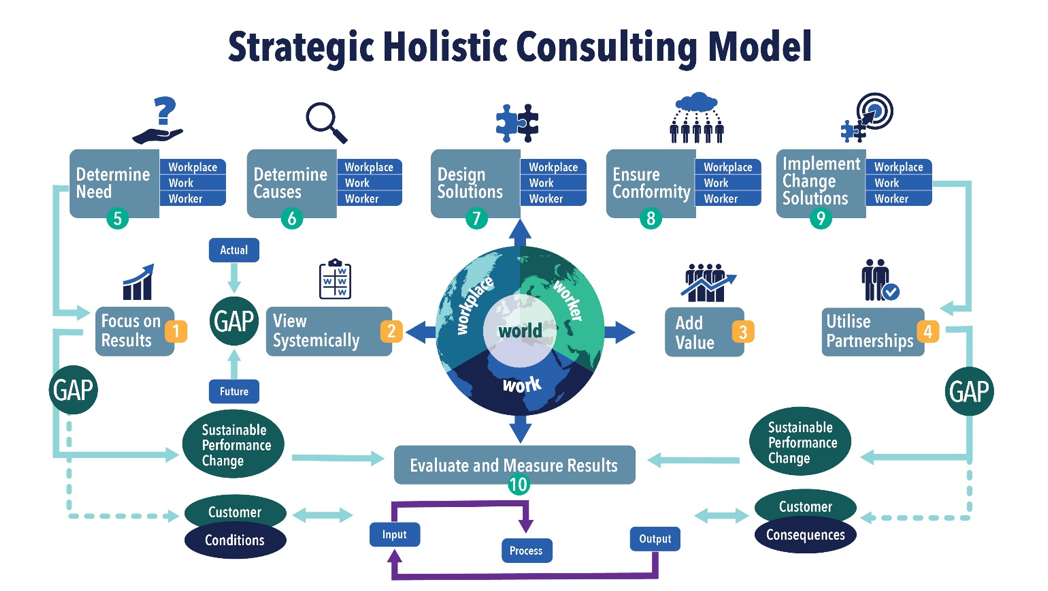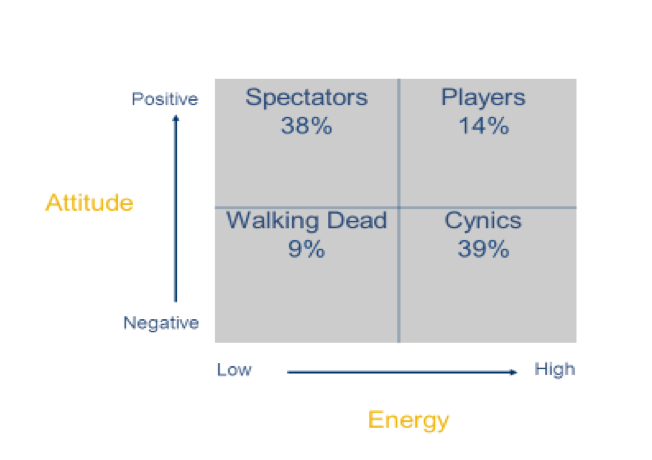For more information about Improvid Performance Consulting visit our Human Performance Improvement website.
Part 2 of a series of articles on the 10 standards for Performance Improvement.
The media is overburdened with “value” deals and bargains. We are continuously bombarded by retailers to buy and spend. And they find creative ways to lure us into shopping malls and online stores. Consultants are continuously being asked, “What value will you add?”
Managers want staff to add value in the work they are doing. But do they know how to?
In part 1 of this series, I focused on holistic performance as a mindset shift to identifying, addressing, and measuring performance issues in organisations. Below is the model to remind us of the practices, principles, and foundation of holistic performance.
In a series of articles, I will focus on the 10 Standards for Performance Improvement. Each standard is numbered in the model for ease of referencing. You can find a full explanation of these standards at www.ispi.org.
As a recap of what we said in the previous article, the first four standards are known as principles because they are fundamental to the other standards that make up the systematic methodology. The first four standards are:
- Standard 1: Focus on results or outcomes
- Standard 2: Take a systemic view
- Standard 3: Add value
- Standard 4: Work in partnerships
We work with partners (4) so that we can provide value (3); we add value because we apply a systemic view (2) to performance issues and needs; and, therefore, we apply a systemic view so that we can help clients identify the correct result of outcomes (1) based at the correct level (organizational, operational, or people level).
In this article, I will focus on the third and fourth standards.

STANDARD 3: ADD VALUE
We typically add value when we drive costs down and reduce activities, or both. As performance improvement practitioners, we drive value up by identifying the gaps and the causes of the gap through our systems view of performance needs and opportunities. This will in itself ensure that no unnecessary activities are entertained to address the gaps. In our toolbox, adding value is a critical component for successful projects.
Competent performance improvement practitioners add value by using their expertise and experience to identify, address, and measure performance needs and problems in ways that result in better decisions and a higher quality end product. It also ensures that the right performance gap is addressed with the right solutions, considering our systemic view. As indicated before, we start by identifying the problem at an organisational (workplace) level, operational (work) level, and worker (individuals and teams) level. Because of our systemic view, we add value in everything we do as practitioners. It means we consider all factors and barriers that are inhibiting performance.
How is it done?
As performance improvement practitioners, we consider an appropriate range of solutions and the implications before taking action. In our consulting, we help clients to appreciate the importance and value of the work and the consultant’s role in the work, and to conclude that they received greater value from their investment than expected.
We also provide value through:
- Helping clients and stakeholders compare factors such as cost to design, develop, implement, and maintain or sustain each solution; and risks and costs associated with the proposed solutions.
We also help clients to discuss and understand the:
- Likelihood of adoption of new behaviours.
- Probability of achieving the desired goals.
- Implication or possible impact on stakeholders.
- Ability of the team, business unit, or organisation to sustain the solution.
Additionally, we help clients to:
- Have courage and integrity, respectfully push back and challenge assumptions.
- Represent themselves honestly, not as having expertise beyond their capabilities.
- Effectively manage time and resources in their areas of responsibility.
Practical guidelines:
In consulting with our clients, managers, and all stakeholders, we:
- Point out that the goal of the solution is to bring new employees to proficiency faster, comply with regulations, and address and satisfy an organisational need or opportunity.
- Present facts related to the performance need and point out the costs, risks, and dependencies of success, such as lack of support, lack of technological infrastructure, lack of incentive or consequence for using the solution, and a significant change in culture.
- Point out what other interventions may be required to fully realise the opportunity or satisfy the need.
- Guide the client or team in choosing the solution with the best value added.
- Identify where the need or opportunities lie for the organisation or key clients.
- Utilise the appropriate tools to facilitate discussions and gather information on how to best address the gap or the opportunity.
- Challenge ideas that are based on incorrect assumptions and solutions.
- Provide solutions that are aligned with the organisation’s goals and capability to implement because of our systemic view.
- Help clients see how to use a particular solution in an innovative way.
A practical tool:
One of the major and important ways to add value to client organisations is our ability to identify and remove barriers to performance. In a typical input-process-output approach, we will identify barriers in a systemic view to add value.
Consider which barrier that categories – when removed – are most likely to add value. Use the tool below in a consultative way and get multiple feedback input before confirming with your client. Obtain feedback from the identified employee group, managers, team leaders, and other stakeholders to improve performance.

STANDARD 4: WORK IN PARTNERSHIPS
The other critical tool in our toolbox is our ability to choose the right partners to address performance needs.
Competent practitioners collaborate with clients and stakeholders so that they share responsibility for the success of the project and make the best choices about accomplishments, priorities, and solutions. The ultimate goal is that client needs are met in a sustainable way.
Involve the client and all stakeholders in the decision making around every phase of the process. For example, we do the following:
- Engage specialists as needed.
- Listen closely to the client.
- Gain their trust and respect.
- Are honest with them.
- Build partnerships.
- Ensure the voices of all vested stakeholders are sought and integrated into the design of the solution.
- Give credit to everyone who contributes to the project.
- Foster open communication within and between groups.
Practical guidelines:
In consulting with our clients, managers, and all stakeholders, we:
- Make sure there is a program sponsor or champion.
- Negotiate and agree the sponsor’s level of involvement.
- Establish relationships with other influential leaders who may affect stakeholders of the project.
We establish appropriate relationships with individuals, governments, community leaders, and stakeholders where appropriate to ensure:
- Their input is acknowledged.
- Their needs are satisfied.
- A solid business case for change or the recommended solution.
- The required support when it comes time for implementation.
- Other engaged functions are mutually beneficial.
Additionally, we also:
- Recommend specialists outside of your expertise.
- Draw on the expertise of specialists who can contribute to the development of strategy, design materials, or facilitation and training mechanisms.
- Facilitate discussions about understanding the gap or need, uncovering the current and desired performance required, anticipating possible resistance, setting priorities, and considering alternatives.
- Make sure the input of all the role-players are integrated into the design of the solutions.
- Recognise the contributions of the subject matter experts and specialists.
A practical tool:
Selecting your partners and role-players to your performance solutions implementation success is critical. The energy investment model (see below) is attributed to Claude Lineberry. He developed a framework for “addressing motivational factors that arise from organisational conditions and climate.”
Both energy and attitude of the role-players and partners will determine the project process and final outcome and the sustainable performance for the future. Tosti and Amarant indicate the importance of a high level of energy and positive attitude as the ultimate goal in choosing your partners and champions. Selecting the “players” as indicated in the model will ensure success and avoid at all cost the “walking dead.”
Energy investment model:

Tosti, Donald T., CPT, and Amarant, John, CPT. Energy Investment: Beyond Competence. Performance Improvement, Volume 44, Number 1, January 2005. Used with permission.
In conclusion, another aspect of the human performance technology results–based and systemic approach is the focus on adding value in everything that performance improvement practitioners are involved in. Because this is seen in context of our guiding principles (the first four standards), it is not overrated or overused but critical to the results and outcomes we bring about for organisations.
Also, choosing the correct partners, champions, and role-players will ensure performance sustainability. This helps many non-practitioners to understand more quickly what we are doing and highlight the differentiators that set us apart.
Over the next 12 months, I will be publishing a series of articles that will focus in-depth on the 10 International Standards of ISPI. Each article will focus specifically on tips, tools, and links to articles, websites, and more. Stay posted!
If you would like to know more about what we do, please visit our website www.improvid.co.za or connect with Belia Nel on LinkedIn.

